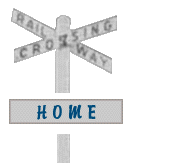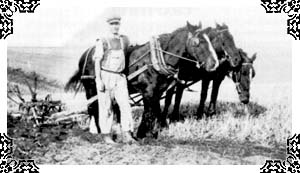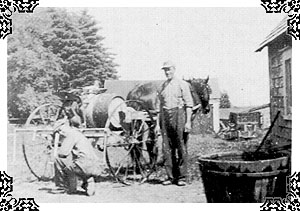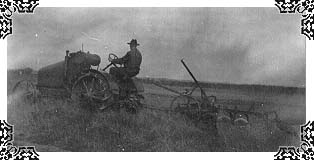







Crop Rotation | Cultivation | Weed and Insect Control | Harvesting
![]()
Farmers have almost always practiced some form of crop
rotation, varying what is planted in a field from year to
year to preserve the soil. A crop like the potato
absorbs more nutrients from the ground than certain other
crops, such as hay
or grain. To prevent the land from
becoming depleted, the farmer rotates the crop he plants
in each of his fields, making certain that the demanding
ones are not grown on the same parcel of land for several
years running. Besides conserving soil nutrients, crop
rotation is an effective means of combating weeds.
When farmers adhered to mixed farming
practices, they used a longer crop cycle known as the
'seven-year rotation'-- a cycle which, despite its name,
could last anywhere from four to eight years. Under this
rotation, a year of potatoes would be  followed
by a year of grain, a clover crop, and then two years as
hay. The field would then be put out to pasture for
another one or two more seasons, and finally a root
crop-- such as potatoes or turnips--
would be planted in the field again. There was an
unwritten, widely respected rule that potatoes were not
to be cultivated in the same field two years in a row.
followed
by a year of grain, a clover crop, and then two years as
hay. The field would then be put out to pasture for
another one or two more seasons, and finally a root
crop-- such as potatoes or turnips--
would be planted in the field again. There was an
unwritten, widely respected rule that potatoes were not
to be cultivated in the same field two years in a row.
However, as farms expanded in the twentieth
century, crop rotations became more and more attenuated.
While mixed farmers had another immediate use for the
land where they grew potatoes last season, it is more
difficult to convince farmers who specialize solely in
potatoes to leave a field fallow for several years
between plantings, especially when they have large
commercial contracts to meet. Nevertheless, most
commercial farmers do not discount the wisdom of the
past, and maintain some system of crop rotation in the
best interests of their land. 
![]()
Believing that deep cultivation would ruin the land,
traditional farmers paid close attention to the depth at
which they were breaking the soil. Perhaps they need not
have worried as much as they did; the spring-tooth
harrows they used were light and only dug into the ground
four to five inches. Since the ground was not loosened
very deeply, the farmer could cultivate more often,
ensuring that the land remained soft and able to retain
moisture.
![]()
The farmer had a whole raft of
different strategies for keeping weeds out of his
well-tended fields. Early spring cultivation and early
fall plowing exposed weed seedlings to sunlight and
killed a significant portion of them. On other occasions,
weeds were simply physically removed, perhaps the only
surefire method of preventing their spread. The problem
of couch grass was combated by plowing buckwheat over the
affected field. Today, weeds are causing more
difficulties than they ever have before, and many blame
this problem on the increased use of fertilizers and soil
degradation.
For early farmers, insect control was none too
complicated. For instance, to rid their gardens of
earwigs, they tried dousing them with dishwater. The
Colorado Potato Beetle was undoubtedly the greatest
insect threat for potato farmers. The first pesticide
used to battle this beetle was called Paris Green,  and
farmers had to shake it on the leaves of their potato
plants manually. Later, there appeared on the market a sprayer
which consisted of a wooden cask on wheels, where the
spraying pump was driven by a bicycle-style chain
attached to the axle. The contraption sprayed faster or
slower, depending on how fast the horses were pulling it
or whether the field went downhill. Before potatoes are
harvested, the potato plant must be killed; most farmers
today use herbicides to assist in killing the tops. In
the past, some farmers did not bother with killing the
tops themselves, waiting instead for the heavy fall
frosts to eventually do the job for them. But when DDT
was introduced after World War II, the widespread use of
chemicals quickly replaced traditional means of weed and
insect control.
and
farmers had to shake it on the leaves of their potato
plants manually. Later, there appeared on the market a sprayer
which consisted of a wooden cask on wheels, where the
spraying pump was driven by a bicycle-style chain
attached to the axle. The contraption sprayed faster or
slower, depending on how fast the horses were pulling it
or whether the field went downhill. Before potatoes are
harvested, the potato plant must be killed; most farmers
today use herbicides to assist in killing the tops. In
the past, some farmers did not bother with killing the
tops themselves, waiting instead for the heavy fall
frosts to eventually do the job for them. But when DDT
was introduced after World War II, the widespread use of
chemicals quickly replaced traditional means of weed and
insect control.
![]()
 Early farmers
cut their fields of grain using scythes
and sickles. But the real job did not even begin until
after the grain was cut. The most difficult task was
'threshing,' or separating the kernels of wheat from the
chaff. At first, the grain would be threshed using
hand-held flails, beaten on the wooden floor until all
the wheat had fallen from the stalk. Later, a horse-driven
machine was adopted, where a team
rode on a treadmill to drive the threshing action. Early
potato harvesting was done by hand, filling baskets that
were left along the side of a row and picked up by a
horse and cart. These methods of harvesting were
extremely labour intensive; when potato diggers
and combines
arrived on the scene, few objections were heard from
weary farm families.
Early farmers
cut their fields of grain using scythes
and sickles. But the real job did not even begin until
after the grain was cut. The most difficult task was
'threshing,' or separating the kernels of wheat from the
chaff. At first, the grain would be threshed using
hand-held flails, beaten on the wooden floor until all
the wheat had fallen from the stalk. Later, a horse-driven
machine was adopted, where a team
rode on a treadmill to drive the threshing action. Early
potato harvesting was done by hand, filling baskets that
were left along the side of a row and picked up by a
horse and cart. These methods of harvesting were
extremely labour intensive; when potato diggers
and combines
arrived on the scene, few objections were heard from
weary farm families.
